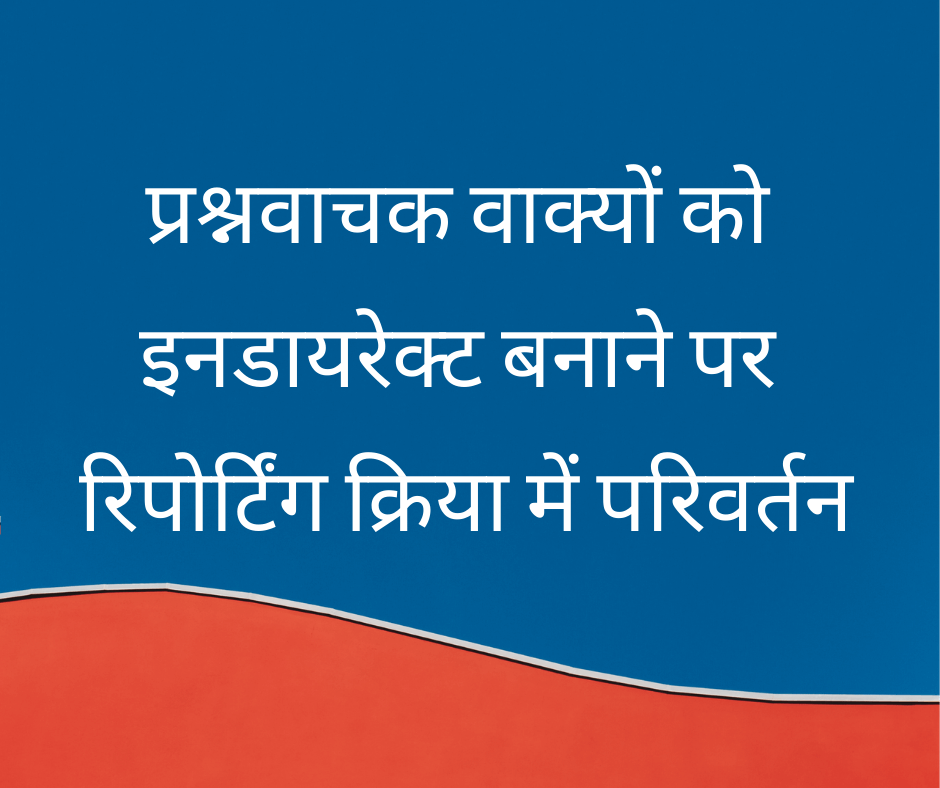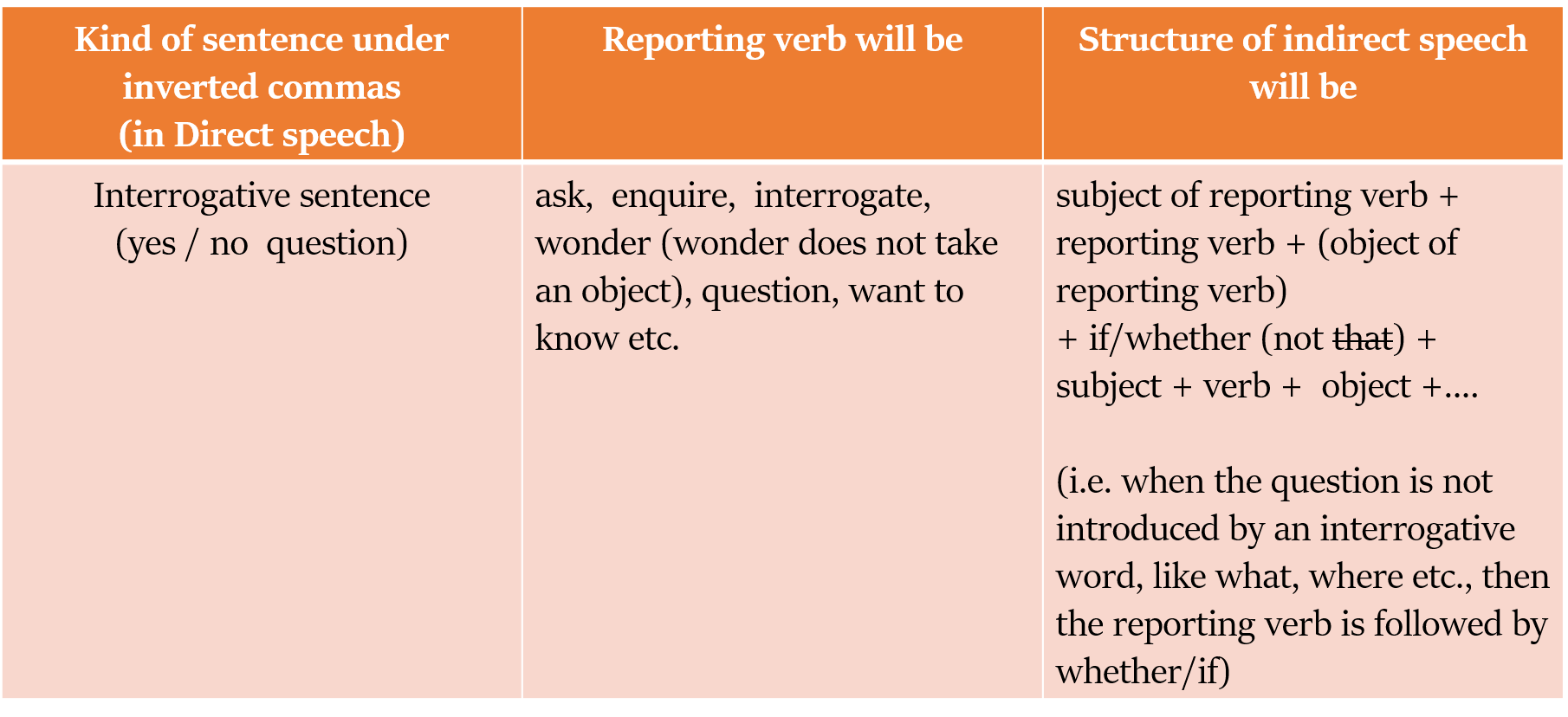प्रश्नवाचक वाक्यों को इनडायरेक्ट बनाने पर रिपोर्टिंग क्रिया में परिवर्तन (Changes in Reporting verb when Interrogative sentences are converted to Indirect Speech)

Overview
इस लेख में हम अंग्रेजी के एक महत्त्वपूर्ण अध्याय के बारे में जानेंगे - Changes in Reporting verb when Interrogative sentences are converted to Indirect Speech, in Hindi (हिंदी में)
 नोट
नोटइस अध्याय से सम्बंधित, अन्य विषयों के बारे में जानने के लिए आप हमारे निम्नलिखित लेख पढ़ सकते हैं:
- डायरेक्ट और इनडायरेक्ट कथन क्या होते हैं?
- डायरेक्ट कथन को इनडायरेक्ट कथन में बदलने के नियम
- डायरेक्ट कथन को इनडायरेक्ट कथन में परिवर्तित करने पर काल में परिवर्तन
- घोषणात्मक वाक्यों को इनडायरेक्ट बनाने पर रिपोर्टिंग क्रिया में परिवर्तन
- आदेशसूचक वाक्यों को इनडायरेक्ट बनाने पर रिपोर्टिंग क्रिया में परिवर्तन
- विस्मयादिबोधक और इच्छावाचक वाक्यों को इनडायरेक्ट बनाने पर रिपोर्टिंग क्रिया में परिवर्तन
हम उल्टे अल्पविराम (inverted commas) के अंदर प्रयुक्त वाक्य के प्रकार के आधार पर ही, reporting verb और direct speech की वाक्य संरचना में बदलाव करते हैं।
उल्टे अल्पविराम (inverted commas) में पाँच प्रकार के वाक्य हो सकते हैं:
- घोषणात्मक वाक्य (Assertive/Declarative)
- प्रश्नवाचक वाक्य (Interrogative)
- आदेशसूचक वाक्य (Imperative)
- विस्मयादिबोधक वाक्य (Exclamatory)
- इच्छा वाचक वाक्य (Optative)
इस लेख में, हम प्रश्नवाचक वाक्यों के मामले में Reporting verb के परिवर्तन को समझेंगे।
प्रश्नवाचक वाक्यों की रिपोर्टिंग क्रिया को बदलना (Changing the Reporting verb in Interrogative sentences)
अवधारणा 1
आरेख:
Direct and Indirect speech
Direct speech: He said to me, “Are you lazy?"
Indirect speech: He asked me if I was lazy.
Direct speech: The old man said to me, " I am old, will you bring some water for me?"
Indirect speech: The old man asked me whether I would bring some water for him as he was old.
अवधारणा 2
आरेख:
Direct and Indirect speech
direct speech को indirect speech में परिवर्तित करते हुए, हम रिपोर्ट किए गए भाषण को घोषणात्मक वाक्य (Declarative sentence) में बदलते हैं।
Direct speech: He said to me, “What is your height?"
Indirect speech: He asked me what my height was.
Direct speech: The doctor said to me, “How and when did you meet with such a fatal accident?”
Indirect speech: The doctor inquired of me that how and when I had met with such a fatal accident. (गलत; ‘that’ का प्रयोग नहीं किया जाना चाहिए)
Indirect speech: The doctor inquired of me how and when I had met with such a fatal accident. (सही)
 नोट
नोट- indirect speech में परिवर्तित करते समय, हमें 'प्रश्न चिह्न (?)' को 'पूर्ण विराम' में बदलना चाहिए।
- चूँकि indirect speech में वाक्य प्रश्नवाचक रूप में नहीं होते हैं, इसलिए सहायक क्रिया (helping verb) का प्रयोग subject के बाद किया जाता है।
- यदि प्रश्न का उत्तर हां/नहीं में दिया जा सकता है → तो हम समुच्चयबोधक (conjunction) if/whether का प्रयोग करेंगे।
यदि प्रश्न 'wh परिवार' का है → हम किसी भी समुच्चयबोधक (conjunction) का प्रयोग नहीं करेंगे।
अवधारणा 3
अगर घोषणात्मक वाक्य (declarative sentence) में प्रश्न टैग (question tag) है, तो प्रश्न टैग को हटा दें, और घोषणात्मक वाक्य को प्रश्नवाचक वाक्य में बदल दें।
Fenni said, “you can’t trust everyone, can you?”
Fenni asked if/whether I couldn’t trust everyone? (asked if/whether का प्रयोग होना चाहिए, ‘said that’ के बजाय)
अवधारणा 4
“yes” के मामले में, ‘answer/reply in the affirmative’ का प्रयोग करें।
“no” के मामले में, ‘answer/reply in the negative’ का प्रयोग करें।
He said, “Are you fine?” I said, “yes”.
He asked if/whether I was fine. I replied/answered in the affirmative.
Ajay said to her, “Have you gone mad?” She said, “No”.
Ajay wanted to know from her whether she had gone mad. She replied in the negative.
अवधारणा 5
need और needn’t के मामले में हम निम्नलिखित संरचनाओं का उपयोग करते हैं।
Direct speech: Subject + say/said ......., + “need + Subject + Main verb +....... ?”
Indirect speech: Subject + ask/inquire/......+ if/whether + Subject + had to / have to + ........
Direct speech: Mak said to Mayank, “Need I go to temple?”
Indirect speech: Mak asked Mayank if he had to go to temple.
Direct speech: Subject + say/said......, “needn’t + Subject + Main verb +.......?”
Indirect speech: Subject + ask/ inquire ....................... + If/ whether + Subject + needn’t + .....
Direct speech: Heather said, “Needn’t we meet tomorrow?
Indirect speech: Heather asked if they need not meet the next day.
अवधारणा 6
dare and daren't के मामले में हम निम्नलिखित संरचनाओं का उपयोग करते हैं।
Direct speech: Subject + say/said....., “Dare + Subject + Main verb .....?”
Indirect speech: Subject + ask/inquire/ .....+ If/ whether + Subject + dare / dared +
Direct speech: Mr. Sharma said to her, “Dare you speak something before your father?”
Indirect speech: Mr. Sharma asked her if she dare speak something to her father.
Direct speech: Subject + say/said........., “Daren’t + Subject + Main verb + ...........?”
Indirect speech: Subject + ask/inquire ....... + if / whether + Subject + daren’t + .............
Direct speech: Mr. Sharma said, “Daren’t you touch Anand?”
Indirect speech: Mr. Sharma asked if I daren’t touch Anand.
अवधारणा 7
आइए हम उन संरचनाओं को देखें जिनका उपयोग हम "how about/what about + + ing" के मामले में कर सकते हैं।
Indirect speech पैटर्न 1: Subject + suggest/propose + + ing........
Direct speech: Alia said, “How about walking on the terrace?”
Indirect speech: Alia suggested walking on the terrace.
Indirect speech पैटर्न 2: Subject + suggest/propose + to + Object + that + we/they + should + ....
Direct speech: Alia said to Ankita, “what about spending some time together in the gym?Indirect speech: Alia proposed to Ankita that they should spend some time together in the gym.
अवधारणा 8
प्रश्नवाचक वाक्य के मामले में, जो अनुरोध (request) की भावना व्यक्त कर रहा है, हम निम्नलिखित संरचनाओं का उपयोग करते हैं:
Indirect Speech पैटर्न 1: Subject + request + + ing .............
Direct Speech: He said, “could you please repeat the question?”
Indirect Speech: He requested repeating the question.
Indirect Speech पैटर्न 2: Subject + request + Object + to + .......
Direct Speech: He said to me, “could you please repeat the question?”
Indirect Speech: He requested me to repeat the question.

अतिरिक्त पुस्तकें और उपकरण
यदि आप किताबों के माध्यम से सीखना पसंद करते हैं, या संदर्भ उद्देश्यों के लिए कुछ अच्छी अंग्रेज़ी व्याकरण किताबें चाहते हैं, तो आप हमारा यह लेख पढ़ सकते हैं|